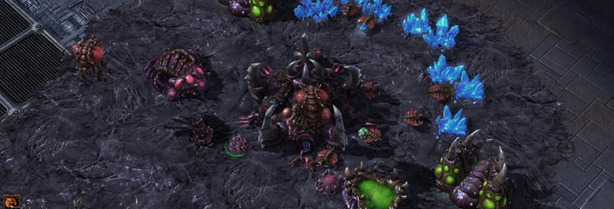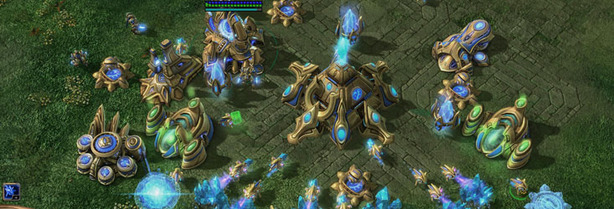
Wings of Liberty
For those of you who are newer to the world of StarCraft than even I am, it’s probably worth going over the basics. So, simply put, StarCraft 2 is a strategy game which, as far as I can tell, doesn’t actually involve any real battle strategy.Instead, the focus of the game (at least, if you want to win a game) is pretty much solely on economic strategy – which is an admittedly odd observation to make of a game that simplifies everything in the world down into three resources. Still, it’s true.
There are three types of resource, all neatly summed up in the top right of the screen as part of StarCraft 2’s wonderfully informative interface. Minerals and Vespene gas are naturally occurring elements which are used for construction and training and they are usually focused into certain areas of the map. At the start of every match you need to build a refinery for Vespene and bolster your fleet of worker units to ferry both gas and minerals into your base.
The worker units (or drones or SCVs, depending on which race you play as) are the most basic element of your army and through them you assemble new buildings, harvest resources and do all the grunt work that keeps your base ticking over. A crucial area where SC differs from other strategy games is that you need to assign these units to build things, rather than just being able to do so magically because you’ve gone through the right steps in the tech tree ala C&C.
The third resource type dictates how large your army can be through the number of command units you have. At the start of each game you only have one command unit, which is different for each race, and that limits how big you can get. As you grow your army you need to periodically built more of them to increase your output.
Beyond that, the basic gameplay is almost exactly as you’d expect to see in any other strategy game, though with minor changes for each race. You create a barracks and create basic infantry. Tech labs and their analogues allow upgrades. Factories bestow vehicles. It goes on, allowing for cosmetic differences.
Or, at least, mostly cosmetic. The alien Zerg forces may be all gooey-looking and focus on ‘mutations’ rather than construction, but they also create a generally faster and melee-focused breed of warriors. Likewise, the cybernetic Protoss are slower to spawn on the whole but get some wonderful power-ups and ranged units as a result of their advanced tech. Terrans straddle the fence like bullied youngsters, creating all-round units that uncomfortably exist between specialties. They’re like Wotsits – neither a crisp, nor a savoury snack and yet possessing the attributes of both.
And yet, despite the similarities between StarCraft 2 and other strategy games, there’s still one tiny difference which completely changes the entire game – the complete lack of in-game credit. Unlike C&C and its kin, you can’t queue up items before you have the required resources for them, allowing supplies to trickle through over time.
Instead, as soon as you click the icon the full amount is debited from your stores and the requested item goes into production. You can queue up a bunch of things at once, but you have to pay in advance. It’s like ordering something off the internet with a debit card. A box of wotsits, for example.
It sounds like a tiny tweak. It is a tiny tweak, but it radically changes to flow of the game and in the long-run removes most battle strategy from the game as savvy players learn how the best economic growth patterns. Build queues and learning how to time your clicks so as to ensure that units go into production at exactly the right time; these are the keys to winning a match of StarCraft 2, not intelligent use of the high ground or carefully planned flank attacks.
You can have the most audacious and ingenious warplan ever plotted, but the reality is that nine times out of ten you’ll be squashed before you can very far by, what else, a Zerg rush. Clever players know that a good build plan will give them three or four low-level infantries before their enemy has even assembled a refinery – and that, at that stage, that’s all you need to win.

MSI MPG Velox 100R Chassis Review
October 14 2021 | 15:04











Want to comment? Please log in.